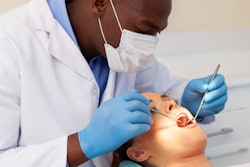
The Occupational Safety and Health Administration (OSHA) may soon issue new infectious disease standards that include unannounced inspections at dental practices, according to a February 26 session at the virtual 2021 Chicago Dental Society Midwinter Meeting.
Workplace safety is expected to be a focus for OSHA in 2021, said Mary Govoni, RDH, CDA, during an infection control presentation at the meeting last week. Govoni, who is a consultant and certified OSHA outreach coach, said OSHA standards are also a priority of President Joe Biden's administration.
 Mary Govoni, RDH, CDA.
Mary Govoni, RDH, CDA."Word on the street is that there are going to be new OSHA infectious disease standards in the spring," Govoni said. "One thing to dread about spring, perhaps?"
OSHA inspections may already be on the rise. Between March 1, 2020, and February 25, 2021, OSHA conducted 40 inspections at dental practices.
"That's a pretty large number," Govoni said.
Most practices were inspected because of filed complaints, and the rest were likely from referrals from dental boards or other agencies that thought the practices engaged in actions that put workers at risk. Govoni said many of the inspections occurred in Michigan, which has a state emphasis plan that permits unannounced inspections for a specific issue, such as respiratory protection. Govoni warned something similar could happen at the federal level.
"We haven't had unannounced OSHA inspections in a very long time," she said. "If this standard gets finalized and they create a [federal] special emphasis program, then everyone will be subjected to a random inspection from OSHA. That's a little scary. But if you're prepared, you're good."
Notably, all citations issued to practices by OSHA in the past year were related to respiratory protection, Govoni said. In one case, workers wore required N95 respirators during aerosol-generating procedures, but they hadn't undergone the OSHA-required fit testing or undergone medical evaluations. In other cases, OSHA cited practices in which dental teams did not wear N95 or higher respirators, and the practices could not provide documentation that they attempted to get them.
"They said they did, but it wasn't documented," Govoni added.
Pass or fail
Even without a U.S. special emphasis program, practices are expected to have the following at the time of an OSHA inspection:
- A written exposure control plan
- A written general infection control plan
- A written hazard communication plan, which addresses chemical safety related to disinfectant use
- A respiratory protection plan, which includes medical evaluation and fit-testing records for employees
- A COVID-19 preparedness and response plan, which includes exposure determination and hazard assessment
- Written protocols that are followed if a COVID-19 exposure occurs within a practice
"If it is in writing and updated and you have the honor of being inspected, you'll be ready to pass that inspection," Govoni said.
Don't turn to a 3rd party
Govoni also often hears complaints from dentists who have trouble getting fit testing for respirators and medical evaluations. She advised against outsourcing fit testing and training.
"No one should be outsourcing their fit testing," she said. "All you need is training and a fit-test kit, and someone can do it in-house."
A fit test costs about $200 or more, but many also come with a training video. A dentist can designate an employee as a fit tester and have the person watch the video and then test respirators for the practice's employees, she said.
In addition, medical clearance evaluations can be performed online for about $25 per employee, Govoni noted. If a practice has respirators fit tested by an occupational health center, it may charge $200 for one employee medical exam and another $200 for the person's fit test. If a practice must change respirators in the future and can't do it in-house, the practice will need to pay the health center to perform the service again.
"If you have a team of 10 people, that's a pretty big chunk of change," Govoni added.




















